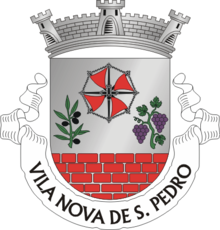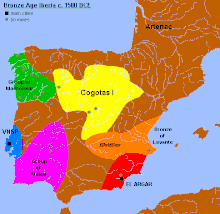Vila Nova de São Pedro settlement
Coordinates: 39 ° 13 ′ 13 ″ N , 8 ° 50 ′ 24.2 ″ W.
The Copper Age settlement of Vila Nova de São Pedro in the Azambuja district is located northwest of the A1 (motorway) near Cartaxo in Portugal . The remains of the wall lie on a spur called Cabeco do Castelo or Alto do Castelo - reference to a medieval castle - above the valley of the Ribeira de Almoster. The Copper Age complex was originally visible as a hill.
Excavations have been going on since 1936, but it wasn't until 1955 that the first scale plan was taken. It shows an inner citadel made of thick walls with bastions in front, which reveal at least two construction phases. However, as in Zambujal , there were probably a lot more extensions and conversions. At the beginning of the excavation period, the interior was cleared very quickly with the help of a wagon , for which a wide opening was made in the wall. The actual entrance was spared. It is slightly shifted to the southwest. In 1959, a cut was made through the southwest side of the complex, which also cut a front bastion. As a result, the first detailed stratigraphic findings were obtained, which still play a role in the Portuguese Copper Age chronology today ; however, the excavation diary was lost.
Around the wall of the citadel there is a second wall ring, which has been excavated in some places. Due to the structure of the terrain, at least one more wall can be assumed towards the site. Between the inner fortifications and the second line, especially in the south, numerous remains of the foundations of round houses and hearths were discovered, of which nothing can be seen today. In the center you can see a semicircular construction leaning against the north side of the wall, which could have been a kind of dome structure. It was interpreted by A. do Paco as a ceramic kiln , but this explanation seems doubtful for various reasons. In front of it on the left a deep pit is interpreted as a cistern . Other pits could be declared as storage pits.
Outside the citadel, a ritual was discovered on the northwest side. First a large pit, roughly trapezoidal in plan, was dug into which a cattle and other animals were placed, over which a fire had been lit. A small vessel was placed on one side. The whole thing was covered with clay and a layer of stone. A ceramic vessel 38 cm high and 58 cm in diameter containing animal bones was placed on top. A small stone wall had been built around the vessel. The rest of the pit was filled with clay . Another layer of clay one meter thick was applied over another layer of stone. In the east of the pit another cattle was placed in the clay. Over the pit was a layer of earth about 60 cm thick, which contained the floors of the hut and a lot of finds. The large, completely preserved vessel is in the Lisbon Museum (Carmo Monastery).
The remains of a copper pouring site were discovered in the south between the 1st and 2nd wall line. In the 1980s, interesting wall findings were uncovered in the north of the complex, primarily between the 2nd and 3rd wall line. In 1988 the Assembleia Distrital de Lisboa adopted a new plan for the internal fortifications. The ceramics of the square indicate a settlement from the beginning of the Copper Age to its end or into the Bronze Age. Individual finds are in the museums of Europe, so z. It can be found in the Ashmolean Museum in Oxford, in the Archaeological Museum of Barcelona, but the bulk of the finds are in Lisbon (Museu Arqueológico in the Carmo Monastery) and in the Museum of Alenquer.
literature
- Thomas G. Schattner (Ed.): Archaeological guide through Portugal (= cultural history of the ancient world . Vol. 74). Philipp von Zabern, Mainz 1998, ISBN 3-8053-2313-1 , p. 157ff.


